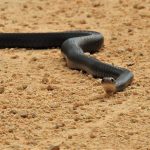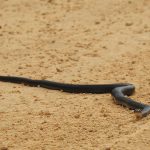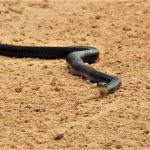GREATER BLACK WHIPSNAKE
The Greater Black Whipsnake
In the sun-dappled woodlands of northern Australia, a slender and elusive creature glides through the underbrush—the Greater black whipsnake (Demansia papuensis). This venomous snake, also known as the Papuan whip snake, is a testament to the intricate beauty of Australia’s diverse wildlife.
Physical Characteristics
The Greater black whipsnake is distinguished by its long, slender body, which can reach lengths up to 1.5 meters. Its coloration ranges from light to dark brown or black, with a tan head adorned with small dark spots. The underbelly is typically greyish, providing a subtle contrast to its dark dorsal side. This coloration not only offers camouflage within its woodland habitat but also adds to its enigmatic presence.
Habitat and Distribution
Primarily found in the northern regions of Australia—including the far north-east of Western Australia, the northern parts of the Northern Territory, and Northern Queensland—the Greater black whipsnake inhabits open forests and woodlands. Its preference for these environments underscores its adaptability and the ecological richness of these areas.
Behaviour and Diet
As a diurnal and arboreal species, the Greater black whipsnake is active during the day and often seen navigating through trees and shrubs. Its diet primarily consists of lizards, including skinks and geckos, which it hunts with remarkable agility. This diet not only sustains the snake but also helps regulate the populations of these lizard species, maintaining a balanced ecosystem.
Venom and Interaction with Humans
While the Greater black whipsnake is venomous, its bites are rare and generally not considered dangerous to humans. Nonetheless, any snakebite should be treated with caution, and medical attention should be sought promptly. In Queensland, Australia, the Greater black whipsnake is classified as a second-level dangerous snake, reflecting its venomous nature and the importance of respecting its presence in the wild.
Conservation Status
Currently, the Greater black whipsnake is listed as a species of least concern, indicating a stable population. However, ongoing conservation efforts are essential to preserve its natural habitats and ensure the continued health of its populations. Protecting these environments not only benefits the Greater black whipsnake but also the myriad other species that share its woodland home.
A Glimpse into the Wild
Imagine walking through a sunlit forest, the air filled with the earthy scent of damp soil and the rustle of leaves underfoot. Suddenly, a sleek, dark form darts across your path, disappearing into the underbrush. It’s the Greater black whipsnake, a fleeting yet captivating presence in the tapestry of Australia’s natural world. Its swift movements and elusive nature remind us of the delicate balance that sustains our ecosystems and the importance of preserving these habitats for future generations.
By understanding and appreciating the Greater black whipsnake, we gain insight into the complex and interconnected web of life that defines Australia’s unique wildlife.



